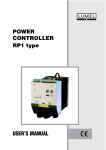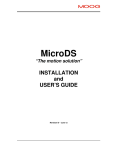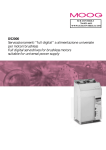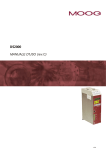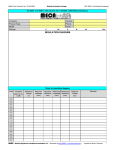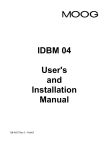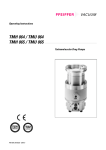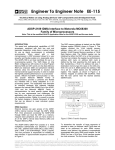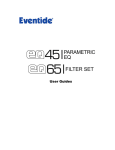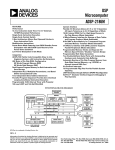Download IDMA INSTALLATION MANUAL (rev.1)
Transcript
IDMA INSTALLATION MANUAL (rev.1) GB-4563 INDEX I.1 INDEX OF REVISIONS Revision Date 0 Jul 06 1 Jan 07 Description Preliminary Release UL approval, 6 axes standard, correct miscellaneous errors IDMA INSTALLATION MANUAL (rev.1) Updated section Par.I.5, I.6, I.7, I.8, I.9, 1.5, 1.7, 1.7.1, 2.10.1, 2.10.3, 2.10.3.1, 2.10.4, 2.10.4.1, 2.10.4.2, 5.9, 5.12, 5.14 Fig.1.1, 1.1A , 1.2, 1.3, 2.1, 2.2, 2.5, 2.6, 3.3, 5.6 , 5.8 Tab.2.6, I.2 INDEX INDEX OF CONTENTS Using the manual Accident protection EC declaration of conformity EC requirements UL authorization UL requirements SAFETY certificate SAFETY requirements (Restart Interlock Function) Legal aspects I.1 I.2 I.3 I.4 I.5 I.6 I.7 I.8 SECTION 1 Description Introduction General features Options Dimensions and drilling jig Technical data Interfaces Markings 1.1 1.2 1.3 1.4 1.5 1.6 1.7 SECTION 2 Wiring and installation Fuses Soft-start Recovery circuit Dynamic braking circuit Fans Display Led’s Reset button Rotary switches (Axis identifier) Wiring 2.1 2.2 2.3 2.4 2.5 2.6 2.7 2.8 2.9 2.10 SECTION 3 Electromagnetic compatibility (EMC) 3.1 European directive (89/336/EEC) 3.2 Filtering 3.3 Wiring and grounding External DC Bus short circuit resistor / Motor 3.4 choke Screening 3.5 3.6 Safety aspects SECTION 4 Protections Fault Related To Input Power Supply Section Fault Related To Drive Module Section INDEX IDMA INSTALLATION MANUAL (rev.1) I.9 4.1 4.2 INDEX SECTION 5 Restart Interlock Circuit (RIC) Intended application Restart interlock function Safety requirements Restart interlock circuit Restart interlock connections Safety Relays – Technical data Sequence and procedure using the restart interlock Anti freewheeling stop function Checking the restart interlock External plausibility tests Application example Installation and routine test RIC label RIC label position IDMA INSTALLATION MANUAL (rev.1) I.3 5.1 5.2 5.3 5.4 5.5 5.6 5.7 5.8 5.9 5.10 5.11 5.12 5.13 5.14 I.4 INDEX I.1 USING THE MANUAL This manual provides the necessary information for a proper installation and use of the IDMA servodrive. The IDMA drives are designed to be easily installed; it is not necessary any specific skill concerning servodrives to start it up. Anyway, the installer should have basics of electronics/electrotechnics, of servodrives, and of safety. The IDMA is a digital servodrive, which can be configured via software as a computer, according to the application requirements. It is recommended to read carefully the manual before the installation. After the installation, and before starting up the motor it is also recommended to check all the system parameters to ensure a correct system configuration. Particular attention must be used to safety instructions. IDMA INSTALLATION MANUAL (rev.1) INDEX I.5 I.2 ACCIDENT PROTECTION The safety instructions provided in this Manual are included to prevent injury to personnel (WARNINGS) or damage to equipment (CAUTIONS). See Section 5 for safety instructions related to the Restart Interlock Function. WARNING: High Voltage. Device can have voltage ≥810Vdc even after switching off (capacitive voltage). Discharge Time approx. 6 Minutes. WARNING: High Voltage. The recovery resistor is connected to the Bus Bar’s and can have voltage ≥810Vdc. WARNING: do not touch recovery resistor during operation to avoid scalds CAUTION: make sure that the correct input voltage, 400V or 460V, has been connect CAUTION: it is recommended to disconnect the drive and the EMC filters to carry out the AC Voltage Tests of EN 60204-1 (1997), par.19.4, in order to not damage the Y-type capacitors between phases and ground. Moreover the DC voltage dielectric test required by EN 50178 (1997), product family standard, has been carried out in factory as a routine test. The DC Insulation Resistance Tests of EN 60204-1 (1997), par.19.3, may be carried out without disconnecting the drive and the EMC filters. CAUTION: when required for an emergency stop, opening U2-V2-W2 pins and closing motor phases to resistors, must be preceded by disabling the axis. The delay time must be at least 30 ms. CAUTION: in case of repetitive switching on and off, wait 1 minute between on and on. CAUTION: do not exceed the tightening torque of the table (but see proper data sheets for the tightening torque of input capacitors and power modules and see Section 2 of this Manual for the tightening torque of terminal blocks) Screw Thread M3 M4 M5 M6 M8 Tightening torque [Nm] [lb in] 1.00 8.85 3.00 26.55 6.00 53.10 8.00 70.80 20.0 177.0 IDMA INSTALLATION MANUAL (rev.1) I.6 INDEX I.3 EC DECLARATION OF CONFORMITY IDMA INSTALLATION MANUAL (rev.1) INDEX I.7 I.4 EC REQUIREMENTS • Cautionary Marking. See Accident Protection page. • Protection against electric shock. Electronic Equipment intended for installation in closed electrical operating areas kept locked. The lock shall be only opened by authorized person and the access only allowed to skilled persons whilst energized. Where the equipment requires manual intervention, 412.2.1 of HD 384.4.41 S2 shall be consulted. • Fixed connection for protection. The equipment may have a continuous leakage current of more than a.c. 3.5 mA or d.c. 10 mA in normal use and a fixed ground connection is required for protection. • RCD. When the protection in installations, with regard to indirect contact, is achieved by means of an RCD, their appropriate function/combination shall be verified. In any case only a residual-current-operated protective device (RCD) of Type B is allowed. In fact a d.c. component can occur in the fault current in the event of a fault connection to earth. • Climatic Conditions. Equipment intended to operate within its performance specification over the range of Class 3K3, as defined in table 1 of EN 60721-3-1, EN 60721-3-2, EN 60721-3-3, EN 60721-3-4, partly modified. • Pollution Degree 2 Installation - The equipment shall be placed in a pollution degree 2 environment, where normally only non-conductive pollution occurs. Occasionally, however, a temporary conductivity caused by condensation is to be expected, when the electronic equipment is out of operation. • EMC Requirements. The installer of the equipment is responsible for ensuring compliance with the EMC standards that apply where the equipment is to be used. Product conformity is subjected to filters installation and to recommended procedures, as from Section 3 of this Manual. • Second Environment (EMC). Equipment intended to be connected to an industrial lowvoltage power supply network, or public network which does not supply buildings used for domestic purposes (second environment, according to EMC Standards). It is not intended to be used on a low-voltage public network which supplies domestic premises (first environment). Radio frequency interference is expected if used on such a network. • Optional external DC Bus short circuit Resistor Cable. Shielding of the resistor cable is recommended for ensuring compliance with the EMC standards. • Large-Scale Stationary Industrial Tools (WEEE, RoHS). Equipment intended for installation as part of large-scale stationary industrial tools, covered by the exception of Annex IA, No.6, of the European Directives 2002/96/EC (WEEE) and 2002/95/EC (RoHS). IDMA INSTALLATION MANUAL (rev.1) I.8 INDEX I.5 UL AUTHORIZATION (page 1) IDMA INSTALLATION MANUAL (rev.1) INDEX UL AUTHORIZATION (page 2) IDMA INSTALLATION MANUAL (rev.1) I.9 I.10 INDEX I.6 UL REQUIREMENTS • These Brushless Servo-Drives shall be assembled with the guidelines specified in this Manual. Only the configurations with the components tested and described in the UL Report, file E194181, Vol.1, Sec.4, can bear the Listing Mark. • These drives shall be used within their ratings, as specified in the marking of the equipment. • Cautionary Marking. See Accident Protection page. • Duty Cycle. The maximum continuous Drive output Power shall be limited to 12kVA. According to this reason, the Drive shall be used with a Duty Cycle, as specified in the marking of the equipment. • Surrounding Air Temperature. "Maximum Surrounding Air Temperature 40°C". In the final installation considerations shall be given for the need of repeating Temperature test if the unit is mounted with a different Surrounding Air conditions. • Pollution degree 2 Installation. The drive must be placed in a pollution degree 2 Environment. • Environmental designation. “Open Type Equipment”. • Short Circuit Ratings. Equipment suitable for use on a circuit capable of delivering not more than 5000 rms Symmetrical Amperes, 480 Vac +10% maximum • Branch Circuit Protection. The Branch Circuit Protection for Short Circuit shall be provided in the end-use applications by external R/C Fuses (JFHR2), manufactured by Bussman Div Cooper (UK) Ltd, Semiconductor fuse type, rated 660 Vac, 200 kA A.I.C., 160A, 4600 A2sec, Mod. No. 160 FEE. Fuses by other manufacturers can also be used provided that fuses are UL Listed or Recognized and with the same ratings. • Overspeed Protection. The Power Conversion Equipment is incorporating an Overspeed Protection. See IDMA User’s Manual. • Overvoltage Control. The Transient-Overvoltage in the Power Supply Primary Circuit of the end-use applications, is controlled by the following devices: Internal (provided) R/C Transient-Voltage-Surge Suppressors devices (XUHT2) and CSA-Certified (according to the United States Standard UL508C). The Marking may indicate the maximum value of Clamping Voltage and the Category-“PermanentlyConnected” (Cat-PC/Surge-Current 10kA–6kV), of these Overvoltage Protection devices. External (recommended) R/C Electromagnetic Interference Filters (FOKY2) and CSACertified (according to the Canadian Standard C22.4-No.14-05), Mod.No.Schaffner EMV AG, FN 258-30 followed by 07 or 29 or 33 or 34.. IDMA INSTALLATION MANUAL (rev.1) INDEX I.11 • Overload Protection. The equipment does not incorporate internal overload protection for the motor load. The drive is intended to be used with motors that must have integral thermal protection through a PTC or NTC. • Over-Current Protection. The drive is provided with a current limiting circuitry. See IDMA User’s Manual. • Wiring. The Wire Connectors shall be any Listed (ZMVV) or R/C Wire Connectors and Soldering Lugs (ZMVV2), used with 60°C/75°C copper (CU) conductor only, within electrical ratings and used with its appropriately evaluated crimping tool. The Field Wiring Terminals shall be used with the tightening torque values specified in the Table of the corresponding section of this Manual. The Terminal Blocks ad Connectors for Field Power Connection Wiring and constituted of two components male-female, shall be used only with the combination of components specified in the Tables of the Section two of this Manual. The Auxiliary “Restart Interlock Function PWB” Connector, provided for end-use installation, are intended and shall be connected and used only with a limited de-rated circuitry: max Voltage 30 Vdc, max Current 3 Adc. The Auxiliary Connectors, provided for field connection during the end-use installation connection with external devices, are intended and therefore shall be used for the connection with a Class 2 Power Supply or a Low Voltage Limited Energy source of supply with Class 2 characteristics. Any Auxiliary Wiring Terminal Blacks, if provided for end-use installation connection with external devices, shall be used within the ratings specified by the manufacturer. IDMA INSTALLATION MANUAL (rev.1) I.12 INDEX I.7 SAFETY CERTIFICATE IDMA INSTALLATION MANUAL (rev.1) INDEX I.13 I.8 SAFETY REQUIREMENTS (RESTART INTERLOCK FUNCTION) • Controlled Stop Time. The final machine must be able to stop the motors in less than 420 ms. The hazard/risk assessment of the application must demonstrate that within this time persons cannot be injured. The drive can provide the Anti Free Wheeling function to perform the controlled stop. • Free-Wheeling Detection. The external system must be able to detect free-wheeling when the axis does not stop within 420 ms after the Module Enable signal goes away. This system must have the actual motor velocity available. WARNING: The designer must evaluate the machine stopping time during the risk assessment even in case of failure. The machine can present a dangerous overrun in case of failure of the drive. Other protective measures are needed to achieve a safe condition. • Environmental Conditions. Equipment intended to operate within the following environmental conditions: ◊ Ambient temperature: 0 to 40°C ◊ EMC immunity: according to EN 61800-3/A11 :2000 and to EN 61800-3:2005 ◊ Vibration: 2 to 9Hz, 3.0 mm amplitude (peak); 9 to 200Hz, 1 g acceleration ◊ Shock: 10 g, half sine, 6 ms • Enclosure. Electronic Equipment intended for installation in an enclosure providing at least IP54 protection. • Pollution Degree 2. The equipment shall be installed in a pollution degree 2 environment, where normally only non-conductive pollution occurs. Occasionally, however, a temporary conductivity caused by condensation is to be expected, when the electronic equipment is out of operation. • WARNING: When the Restart Interlock Circuit is activated, the motor can no longer generate a torque. Motors which are not automatically clamped when powered down (e.g. vertical/inclined axes), must be clamped using a mechanical brake IDMA INSTALLATION MANUAL (rev.1) I.14 INDEX I.9 LEGAL ASPECTS This manual can be used only by final Customers/Users of the Moog product it describes and only for proper installation purposes. This manual cannot be reproduced in whole or in part without the prior written consent of Moog. No transmission or diffusion of this manual, under electronic, mechanical, or printed form, is allowed. Moog issued this manual attempting to ensure a complete information; anyway, Moog shall not be liable for errors or omissions contained herein and for incidental or consequential damages due to the above mentioned errors and omissions. Moog reserves the right to change and update this manual without notice. This manual has a merely information purpose. There is no obligation for Moog as regard the correspondence of the product features described in the manual with the features of the real product purchased by the final Customer/User. No statement or sentence contained in this manual implies further legal obligations different from the ones contained in each single sale or supply contract concerning Moog products. IDMA INSTALLATION MANUAL (rev.1) SECTION ONE – DESCRIPTION 1.1 1. DESCRIPTION 1.1 INTRODUCTION IDMA servodrives position themselves in the range of very high performance converters thanks to optimized design using advanced power and digital electronics. The result is true added value for the users who appreciate its unrivaled flexibility and reliability. A full digital structure allows high servo performances with FAS T, FAS K, FAS N and FC servomotors which are all equipped with a resolver feedback. Drive tuning and configuration are performed via digital parameters (not potentiometers) and stored in nonvolatile memory (Flash Disk). Drive set is possible via PC, therefore simplifying installation and providing easy fault diagnosis. 1.2 GENERAL FEATURES • • • • • • • • • • • • • • built-in power supply digital control loops sinusoidal current waveform boards automatically assembled and tested automatic resolver to digital (R/D) resolution switching (from 16 to 10 bit) to achieve high motion accuracy in the whole speed range (from 0 to 10000 rpm) 5/10 kHz switching frequency Compact unit (maximum case depth 320 mm) programmable setup of the control loops programmable digital filters built-in fans built-in soft start electronic circuit intelligent IGBT (IPM) power bridge built-in recovery resistor constant motor torque in the whole speed range thanks to dedicated software algorithm indirect field oriented control (IFOC) for squirrel cage induction motor IDMA INSTALLATION MANUAL (rev.1) 1.2 SECTION ONE – DESCRIPTION 1.3 OPTIONS • • • • • software programmable (from 64 to 16384 pulses per electrical revolution) simulated encoder with marker pulse A/D 14 bit converter on the analogic input as alternative to the standard 12 bit version 4 arc/min R/D converter resolution 24 Vdc auxiliary power supply voltage Restart Interlock Circuit safety function. See Section 5. IDMA INSTALLATION MANUAL (rev.1) SECTION ONE – DESCRIPTION 1.4 DIMENSIONS AND DRILLING JIG Fig.1.1 (dimensions in mm) shows the dimensions and the drilling jig of the drive. Leave a clear space of at least 50 cm (19.7 in) over and under the system for air circulation. Fig. 1.1 - IDMA Dimensions and Drilling Jig – Vertical Mounting (Drill For M5 screws) Weight: approx. 32 kg IDMA INSTALLATION MANUAL (rev.1) 1.3 1.4 SECTION ONE – DESCRIPTION Fig. 1.1A - IDMA Dimensions and Drilling Jig – Horizontal Mounting (Drill For M5 screws) IDMA INSTALLATION MANUAL (rev.1) SECTION ONE – DESCRIPTION 1.5 1.5 TECHNICAL DATA Nominal input voltage: 3 x 400 to 480 Vac ±10%, 50/60 Hz Min/max input voltage: 360 / 528 Vac Axis output current: see following chart Nominal Output Current DC side: 25A Peak Output Current DC side: 100A Max. peak braking power: 72 kW for 2 seconds maximum Braking resistor nominal power: 4 kW Switching frequency: 10 kHz Operating temperature: Relative humidity: Air pressure: Storage temperature: Transportation temperature: Immunity to vibrations: Immunity to shocks: Axis 3/9 0 to +40°C (exceeding Class 3K3) 5% to 85% (no condensation/ formation of ice) (Cl. 3K3) 86 kPa to 106 kPa kPa (Class 3K3) -25 to +55°C (Class 1K4) -25 to +70°C (Class 2K3) ±3.0 mm from 2 to 9 Hz, 1 g from 9 to 200 Hz (Class 3M4) 10 g, half-sine, 6 ms Output Current Nominal Max Arms Arms Apeak 3 6.5 9 6/15 6 10.5 15 8/22 8 15.5 22 15/43 15 30.4 43 30/90 35/140 30 35 63 100 90 140 Models can be configured by combining the basic sizes, as long as the total power supplied, taking into account the non-contemporaneity conditions of the axes, does not exceed 12 kVA. IDMA INSTALLATION MANUAL (rev.1) 1.6 SECTION ONE – DESCRIPTION 1.5.1 MODEL CODES Model Codes G365-001 G365-002 G365-003 G365-004 G365-005 G365-006 G365-007 G365-008 G365-009 G365-010 G365-011 G365-012 G365-013 G365-014 G365-015 G365-016 1° axis 2° axis 3° axis 4° axis 5° axis 6° axis 30/90 30/90 30/90 30/90 35/140 35/140 35/140 30/90 35/140 30/90 8/22 35/140 30/90 3/9 3/9 15/43 8/22 8/22 8/22 8/22 8/22 35/140 35/140 30/90 8/22 8/22 8/22 3/9 3/9 3/9 3/9 15/43 -3/9 6/15 8/22 8/22 8/22 8/22 8/22 8/22 8/22 8/22 3/9 3/9 3/9 3/9 8/22 35/140 35/140 35/140 35/140 35/140 30/90 35/140 30/90 8/22 8/22 8/22 3/9 3/9 3/9 3/9 15/43 8/22 8/22 8/22 8/22 8/22 8/22 3/9 8/22 8/22 8/22 8/22 3/9 3/9 3/9 3/9 15/43 3/9 3/9 3/9 3/9 8/22 3/9 3/9 8/22 8/22 8/22 8/22 3/9 3/9 8/22 3/9 8/22 1.6 INTERFACES 1.6.1 AXIS INTERFACES 1.6.1.1 ANALOG • Two analog differential input • Two programmable analog output • resolver signal interface 1.6.1.2 ON/OFF (opto isolated) • Four programmable input • Four programmable output 1.6.2 MODULE INTERFACES • RS 232 serial link • RS 485 serial link • CanOpen Interface IDMA INSTALLATION MANUAL (rev.1) UL Status Approved Approved Approved Approved Approved Approved Approved Approved Approved Approved Approved Approved Approved Approved Approved Pending SECTION ONE – DESCRIPTION Fig. 1.2 - IDMA Control Unit IDMA INSTALLATION MANUAL (rev.1) 1.7 1.8 SECTION ONE – DESCRIPTION 1.7 MARKINGS The following informations are supplied on the front panel of IDMA. AXIS 1 – SIZE xx/yyy A Iout nom xx Arms Iout max yyy A Nominal rms Output Current Peak Output Current AXIS 2 – SIZE xx/yyy A Iout nom xx Arms Iout max yyy A Nominal rms Output Current Peak Output Current AXIS 3 – SIZE xx/yyy A Iout nom xx Arms Iout max yyy A Nominal rms Output Current Peak Output Current AXIS 4 – SIZE xx/yyy A Iout nom xx Arms Iout max yyy A Nominal rms Output Current Peak Output Current AXIS 5 – SIZE xx/yyy A Iout nom xx Arms Iout max yyy A Nominal rms Output Current Peak Output Current AXIS 6 – SIZE xx/yyy A Iout nom xx Arms Iout max yyy A Nominal rms Output Current Peak Output Current IDMA INSTALLATION MANUAL (rev.1) SECTION ONE – DESCRIPTION 1.9 The following informations are supplied on the rating plate of IDMA. MODEL: IDMA CODE: G365-XXX Model Code, where G365=model code, ”-“ or “E”, XXX=model type “-“ = Final Production Designation “E” = Pre - Production Designation S/N: AAMMMGXXX Serial Number, where AA=year, MM=month, MG=MOOG, XXX=serial number Vin: xxx Vac Duty Cycle: xx % Nominal Input Voltage Duty Cycle Auxiliary Input: Vin: xx Vdc Pin: xx W Nominal Input Voltage Nominal Input Power Fan Assembly: Vin: xx Vdc Pin: xx W Nominal Input Voltage Nominal Input Power IDMA INSTALLATION MANUAL (rev.1) 1.10 SECTION ONE – DESCRIPTION 1.7.1 Rating Plate Fig. 1.3 - Rating Plate IDMA INSTALLATION MANUAL (rev.1) SECTION TWO – WIRING AND INSTALLATION 2.1 2. WIRING AND INSTALLATION 2.1 FUSES 2.1.1 THREE-PHASE POWER SUPPLY It is recommended to use the Short Circuit protection in the final application with UL certified external fuses (cat. JFHR2), manufactured by Bussmann Div. Cooper (UK) Ltd, semiconductor type, 660Vac, 200 kA A.I.C.. As alternate fuses by different manufacturers can be used but UL approved (cat. JFHR2) with the same data of the fuses shown in table taking care that the Peack-let-trough-current (A.I.C) and clearing I2T are equal or lower. IDMA drive model Mod. 1 Fuse type 160FEE note Semiconductor Tab. 2.1 – Three-phase recommended fuses 2.1.2 24Vdc POWER SUPPLY It is recommended the Short Circuit protection in the final application using external delayed fuses IDMA drive model Mod. 1 Fuse type 10 [A] note Delayed Tab. 2.2 – 24Vdc recommended fuses 2.2 SOFT-START The soft-start circuit (current limit at start-up) is included in the drive input stage. 2.3 RECOVERY CIRCUIT IDMA drive has internal recovery resistor. 2.4 DYNAMIC BRAKING CIRCUIT It is recommended to size the resistor of the dynamic braking circuit according to the application, the standard value for most applications is 1Ω 100W. IDMA INSTALLATION MANUAL (rev.1) 2.2 SECTION TWO – WIRING AND INSTALLATION 2.5 FANS 2.5.1 POWER UNIT Two built-in fans, powered by an external 24V supply, mounted under the drive provide IDMA drive ventilation. CAUTION: A free air circulation must be ensured for a proper operation. 2.5.2 CONTROL UNIT Two built-in fans, powered by an internal 24V supply, mounted over the drive provide IDMA drive ventilation. CAUTION: A free air circulation must be ensured for a proper operation. 2.6 DISPLAY The display output is application software specific. For the definition see IDMA User’s Manual. See Fig. 2.5. 2.7 LED’S The Led's are application software specific. For the definition see IDMA User’s Manual. See Fig. 2.5. 2.8 RESET BUTTON The RESET (RST) button on the CPU card re-initializes the system. See Fig. 2.5. 2.9 ROTARY SWITCHES (AXIS IDENTIFIER) The rotary switches identify the first axis of the module. The switch of the master module must be set to 4 and the switch of the slave module to 1. See also IDMA User’s Manual and fig. 2.5. IDMA INSTALLATION MANUAL (rev.1) 2.3 SECTION TWO – WIRING AND INSTALLATION 2.10 WIRING 2.10.1 SIZING OF WIRES It is recommended to use Cu, stranded and/or solid wires, 75°C (167°F), UL approved, per the following table. Connector LINE DBU X1 X2 X3 X4 X5 X6 FANS J24V J2 J6 Connector J1 J2 J1A,J1B,J1C J2A,J2B,J2C J3A,J3B,J3C J4A,J4B,J4C J5 J6 J1S IDMA- Power Unit (Mod.1) Cable AWG Section Line Power 10 AWG DC Bus short circuit Resistor 8 AWG Motor Power 8 AWG Motor Power 16 AWG Motor Power 16 AWG Motor Power 8 AWG Motor Power 16 AWG Motor Power 16 AWG 24Vdc Fan Unit Supply 16 AWG +24Vdc Power Supply 14 AWG Power Supply Control Signals 20/22 AWG Serial Interface Power Supply (RS485) 20/22 AWG IDMA- Control Unit Cable Ethernet X.Bus Analog Outputs Digital Input/Output Analog Inputs Resolver Dual CAN-Bus Serial Interface RS232 (RS485) Restart Interlock Function Tab. 2.3 – Sizing of Wires AWG Section 26 AWG 28 AWG 20/22 AWG 20/22 AWG 20/22 AWG 20/22 AWG 20/22 AWG 20/22 AWG 16 AWG Notes shielded shielded shielded shielded shielded shielded shielded shielded shielded shielded shielded Notes shielded shielded shielded shielded shielded shielded ** shielded shielded shielded shielded ** : with each pair twisted and individually shielded with an independent overall shield IDMA INSTALLATION MANUAL (rev.1) 2.4 SECTION TWO – WIRING AND INSTALLATION 2.10.2 AWG/ mm2 CONVERSION AWG mm2 28 0.08 26 0.13 24 0.2 22 0.3 20 0.5 18 0.8 16 1.3 14 2.1 12 3.3 10 5.3 8 8.4 6 13 4 21 3 27 2 34 1 42 2 Tab. 2.4 - AWG/mm conversion IDMA INSTALLATION MANUAL (rev.1) SECTION TWO – WIRING AND INSTALLATION 2.10.3 IDMA POWER UNIT CONNECTORS Fig. 2.1 - IDMA Power Unit Connectors position (Front view) Note: Position 1 is marked with the symbol “■” IDMA INSTALLATION MANUAL (rev.1) 2.5 2.6 SECTION TWO – WIRING AND INSTALLATION Fig. 2.2 - IDMA Power Unit Connectors position (Right side view) Note: Position 1 is marked with the symbol “■” IDMA INSTALLATION MANUAL (rev.1) SECTION TWO – WIRING AND INSTALLATION 2.7 Fig. 2.3 - IDMA Power Unit Connectors position (Left side view) Note: Position 1 is marked with the symbol “■” IDMA INSTALLATION MANUAL (rev.1) 2.8 SECTION TWO – WIRING AND INSTALLATION 2.10.3.1 IDMA Power Unit Connectors Pin Assignments LINE Terminal Blocks – Plant Supply DBU Terminal Blocks – External DC Bus short circuit Resistor Position Function 1■ U1 phase - Three-phase plant supply input 2 V1 phase - Three-phase plant supply input 3 W1 phase - Three-phase plant supply input 4 - Ground input Note: Position 1 is marked with the symbol “■” 1■ DBU - DC Bus short circuit Resistor 2 -AT - DC Bus short circuit Resistor Panel side Terminal Blocks: 6 x PHOENIX type HDFK 16 Notes for Terminal Blocks : - Tightening torque = 2 Nm (18 lb-in) - Wire stripping length = 16 mm (0,63 in) Note: Consult Moog Service Centers to size and use an external DC BUS short circuit Resistor. IDMA INSTALLATION MANUAL (rev.1) SECTION TWO – WIRING AND INSTALLATION 2.9 X1, X2, X3, X4, X5, X6 Connectors – Motor Power Position Function 1■ U2 phase - Three-phase motor output 2 V2 phase - Three-phase motor output 3 W2 phase - Three-phase motor output 4 - Ground Note: Position 1 is marked with the symbol “■” Mating connector: 4 pins, MOLEX type 42816-0412 (cod. MOOG AK4990), terminals MOLEX type 42815-0031 (cod. MOOG AK9062), terminals MOLEX type 42815-0041 (cod. MOOG AK9068) Notes on cabling X1, X2, X3, X4, X5, X6 MOLEX Connectors The relevant contacts (Molex type 42815-0031 and Molex type 42815-0041) are supplied together with the mating power connectors. These contacts are sized for : - 8 AWG cable with a 10 mm wire stripping (terminals MOLEX type 42815-0031) - 14 to 16 AWG cable with a 10 mm wire stripping (terminals MOLEX type 42815-0041). The crimping does not include the insulation sheath. It is recommended the use of a Molex crimping tool type 63814-0000, or Molex type 638111500, or equivalent. As an alternative it is possible to weld the contacts, taking care of folding the contact wirings. After the crimping (or welding), the contact must be inserted into the mating connector, following the proper direction and must be kept in position by the TPA (Terminal Position Assurance) jumper, as shown in following figure. Fig.2.4 – Molex connector fixing IDMA INSTALLATION MANUAL (rev.1) 2.10 SECTION TWO – WIRING AND INSTALLATION FANS Connector – 24Vdc Fan Unit Supply Position Function 1■ +24 Vdc Power Supply Input 2 0V Mating connector: 2 pins, PHOENIX type FK-MCP 1,5/2-STF-3,81 cod.1851232 (cod. MOOG AK4810) IDMA INSTALLATION MANUAL (rev.1) SECTION TWO – WIRING AND INSTALLATION J24V Connector – 24Vdc Power Supply Position Function 1■ +24 Vdc Power Supply Input 2 0V Mating connector: 2 pins, PHOENIX type FKC 2,5/2-ST-5,08 cod.1873058 (cod. MOOG AK4808) J2 Connector – Power Supply Control Signals Position Function 1■ Output Common + 24 VDC 2 Output DC-Bus low signal 3 Input DC-Bus 'keep charged' + 24 VDC 4 Input Common 0 V Mating connector: 4 pins, PHOENIX type FK-MC 0,5/4-ST-2,5 cod.1881341 (cod. MOOG AK4714) IDMA INSTALLATION MANUAL (rev.1) 2.11 2.12 SECTION TWO – WIRING AND INSTALLATION J6 Connector – Serial Interface Power Supply (RS485) Position Function 1■ RX+: data receive input 2 RX-: data receive input 3 TX-: data transmit output 4 TX+: data transmit output 5 0 V logic circuit Mating connector: 5 pins, PHOENIX type FK-MC 0,5/5-ST-2,5 cod.1881354 (cod. MOOG AK4715) IDMA INSTALLATION MANUAL (rev.1) SECTION TWO – WIRING AND INSTALLATION 2.10.4 IDMA CONTROL UNIT CONNECTORS Fig. 2.5 - IDMA Control Unit Connectors position Note: Position 1 is marked with the symbol “■” IDMA INSTALLATION MANUAL (rev.1) 2.13 2.14 SECTION TWO – WIRING AND INSTALLATION 2.10.4.1 IDMA Control Unit Connectors description Tab. 2.5 – CONTROL UNIT Connectors description Module Connector J1 J2 J5 MASTER Module J6 J1C J2C J3C J4C J1B J2B J3B J4B J1A J2A J3A J4A Connector J2 J5 SLAVE Module SAFETY J1C J2C J3C J4C J1B J2B J3B J4B J1A J2A J3A J4A Connector JS1 Description Ethernet X.Bus (Drive internal connection) CAN 1 Bus: to Master-CPU CAN 2 Bus: to Master-CPU and DSP of each axis Serial Interface (RS232, RS485) Axis 3 (6) : Analog Outputs Axis 3 (6) : Digital I/O Axis 3 (6) : Analog Inputs Axis 3 (6) : Resolver to Motor 6 Axis 2 (5) : Analog Outputs Axis 2 (5) : Digital I/O Axis 2 (5) : Analog Inputs Axis 2 (5) : Resolver to Motor 5 Axis 1 (4) : Analog Outputs Axis 1 (4) : Digital I/O Axis 1 (4) : Analog Inputs Axis 1 (4) : Resolver to Motor 4 Description X.Bus (Drive internal connection) CAN 1 Bus: no function CAN 2 Bus: to DSP of each axis Axis 3 (3):Analog Outputs Axis 3 (3): Digital I/O Axis 3 (3): Analog Inputs Axis 3 (3): Resolver to Motor 3 Axis 2 (2):Analog Outputs Axis 2 (2): Digital I/O Axis 2 (2): Analog Inputs Axis 2 (2): Resolver to Motor 2 Axis 1 (1): Analog Outputs Axis 1 (1): Digital I/O Axis 1 (1): Analog Inputs Axis 1 (1): Resolver to Motor 1 Description Safety IDMA INSTALLATION MANUAL (rev.1) SECTION TWO – WIRING AND INSTALLATION 2.10.4.2 IDMA Control Unit Connectors Pin Assignments J1 Connector – Ethernet Position Function 1■ TX+: Transmission signal output (in differential configuration) 2 TX -: Transmission signal output (in differential configuration) 3 CT TX 4 -------5 -------6 CT RX 7 RD+: Reception signal input (in differential configuration) 8 RD -: Reception signal input (in differential configuration) Mating connector: 8 pins, plug RJ45 type TYCO ELECTRONICS cod. 5-569532-3 (cod. MOOG AK4792) IDMA INSTALLATION MANUAL (rev.1) 2.15 2.16 SECTION TWO – WIRING AND INSTALLATION J2 Connector – X.Bus (Drive internal connection) Position Function 1■ 0 V logic circuit 2 IO_0 3 IO_1 4 IO_2 5 IO_3 6 IO_4 7 IO_5 8 IO_6 9 IO_7 10 IO_8 11 IO_9 12 IO_10 13 IO_11 14 0 V logic circuit 15 IO_12 16 IO_13 17 IO_14 18 IO_15 19 IO_16 20 IO_17 21 IO_18 22 IO_19 23 IO_IRQ1 24 IO_BUSY 25 0 V logic circuit 26 0 V logic circuit Mating connector: 26 pins, MINI-D type HARTING cod. 60 13 026 5200 (cod. MOOG AK5831) IDMA INSTALLATION MANUAL (rev.1) SECTION TWO – WIRING AND INSTALLATION J5 Connector – Dual CAN-Bus Position Function 1■ CAN 2 (low): differential CAN 2 signal 2 CAN 1 (low): differential CAN 1 signal 3 0 V logic circuit 4 Not Connected 5 Not Connected 6 0 V logic circuit 7 CAN 1 (high): differential CAN 1 signal 8 CAN 2 (high): differential CAN 2 signal 9 Not Connected Mating connector: 9 pins, Sub-D cup connector HARTING cod. 09670094704 (cod. MOOG AK4751) + hood AMPHENOL cod. 17D TZK 9K (cod. MOOG AK5234) IDMA INSTALLATION MANUAL (rev.1) 2.17 2.18 SECTION TWO – WIRING AND INSTALLATION J6 Connector – Serial Interface RS232 (RS485) Position Function 1■ Not Connected 2 RXD: data receive input 3 TXD: data transmit output 4 DTR: data terminal ready 5 0 V logic circuit 6 DSR: data set ready 7 Not Connected 8 Not Connected 9 Not Connected Mating connector: 9 pins, Sub-D cup connector HARTING cod. 09670094704 (cod. MOOG AK4751) + hood AMPHENOL cod. 17D TZK 9K (cod. MOOG AK5234) IDMA INSTALLATION MANUAL (rev.1) SECTION TWO – WIRING AND INSTALLATION J1A, J1B, J1C Connectors – Analog Outputs Position Function 1■ Analog output 1 referred to ANALOG GND 2 Analog output 2 referred to ANALOG GND 3 Analog Ground for pin 1..2 4 Spare 1 5 Spare 2 6 Spare 3 7 Spare 4 ±10 V range ±10 V range Mating connector: 7 pins, PHOENIX type FK-MC 0,5/7-ST-2,5 cod.1881370 (cod. MOOG AK4717) IDMA INSTALLATION MANUAL (rev.1) 2.19 2.20 SECTION TWO – WIRING AND INSTALLATION J2A, J2B, J2C Connectors – Digital Input/Output Position Function 1■ Digital input signal 1 (opto-isolated) 2 Digital input signal 2 (opto-isolated) 3 Digital input signal 3 (opto-isolated) 4 Digital input signal 4 (opto-isolated) 5 Digital input common for DI 1..4 0V 6 Digital output signal 1 (opto-isolated) 7 Digital output signal 2 (opto-isolated) 8 Digital output signal 3 (opto-isolated) 9 Digital output signal 4 (opto-isolated) 10 Digital output common for DO 1..4 0 V STATE 0 : 0V to 5V ± 5% STATE 1 : 11V to 24V ± 5% Z input min : 1.6 kΩ V nom : 24V V max : 30V Z output : 1 kΩ Mating connector: 10 pins, PHOENIX type FK-MC 0,5/10-ST-2,5 cod.1881406 (cod. MOOG AK4720) IDMA INSTALLATION MANUAL (rev.1) SECTION TWO – WIRING AND INSTALLATION J3A, J3B, J3C Connectors – Analog Inputs Position Function 1■ +15 VDC output power supply (Imax = 125 mA) 2 0V 3 Analog input 1 (+) 4 Analog input 1 (-) 5 Analog input 2 (+) 6 Analog input 2 (-) Mating connector: 6 pins, PHOENIX type FK-MC 0,5/6-ST-2,5 cod.1881367 (cod. MOOG AK4716) IDMA INSTALLATION MANUAL (rev.1) 2.21 2.22 SECTION TWO – WIRING AND INSTALLATION J4A, J4B, J4C Connectors – Resolver Position Function 1■ Differential COS signal input non-inverted 2 Differential COS signal input inverted 3 Shield of twisted cable 4 Differential SIN signal input non-inverted 5 Differential SIN signal input inverted 6 Motor winding PTC resistor input 7 (-) carrier frequency for supplying primary resolver winding 8 Motor winding PTC resistor input 9 (+) carrier frequency for supplying primary resolver winding Mating connector: 9 pins, Sub-D cup connector AMPHENOL cod. 017SDE-9P (cod. MOOG AK5220) + hood AMPHENOL cod. 17D TZK 9K (cod. MOOG AK5234) IDMA INSTALLATION MANUAL (rev.1) SECTION TWO – WIRING AND INSTALLATION 2.23 Fig. 2.6 - Resolver Wiring RESOLVER CONNECTOR DRIVE SIDE MOTOR SIDE Signal Type FAS T / FAS K FAS W FAS N optional COS+ COSSHIELD SIN+ SINPTC 10kHzPTC 10kHz+ Pos. 1 2 3 4 5 6 7 8 9 FAS N standard Pos. Pos. C 1 E 2 S 3 G 11 H 12 N 8 B 7 A 9 D 10 Tab. 2.6 – Resolver Connector IDMA INSTALLATION MANUAL (rev.1) FAS G / FAS J Pos. 3 4 Not available 1 2 5 8 6 7 2.24 SECTION TWO – WIRING AND INSTALLATION Note: For other motors connectors, make reference to the motor catalogue too. Each IDMA module (Master, Slave) can be connected up to 3 resolvers. IDMA Slave Module : see Fig. 2.5 and Tab. 2.5 IDMA Master Module : see Fig. 2.5 and Tab. 2.5 Figure 2.6 shows the wiring lay-out of the resolver with differential output. We recommend to use 4 pair cables, each pair twisted and individually shielded with an independent overall shield. 20 AWG (0.60 mm²) or 22 AWG (0.38 mm²) wire with low capacitance can be used. We suggest to use ground connections as shown in Fig. 2.6. Cable length should not exceed 30 m (100 ft.). It is recommended that the signal cable and power cable be separated, if possible, through the use of independent duct (conduit) or by a distance of 12 inches (30 cm). See Section 3 for shielding procedures according to EMC Directive. IDMA INSTALLATION MANUAL (rev.1) SECTION TWO – WIRING AND INSTALLATION J1S Connector – Restart Interlock Function (See Section 5) Position Name 1■ + Channel 2 door 2 + Channel 1 door 3 GND 4 Module Enable 5 6 Channel 1 Verification 7 8 Channel 2 Verification 9 Mating connector: 9 pins, PHOENIX type FK-MCP 1,5/9-STF-3,81 cod.1851300 (cod. MOOG AK4809) IDMA INSTALLATION MANUAL (rev.1) 2.25 2.26 SECTION TWO – WIRING AND INSTALLATION THIS PAGE INTENTIONALLY BLANK IDMA INSTALLATION MANUAL (rev.1) SECTION THREE – ELECTROMAGNETIC COMPATIBILITY (EMC) 3.1 3. ELECTROMAGNETIC COMPATIBILITY (EMC) 3.1 EUROPEAN DIRECTIVE (89/336/EEC) Compliance with the European Directive 89/336/EEC is required for all electric and electronic products brought onto the European market after December 31st, 1995. IDMA drives with FASTACT motors meet the following EMC product standard related to the Directive: EN 61800-3/A11 (2000) and EN 61800-3 (2005): "Adjustable speed electrical power drive systems. Part 3: EMC product standard including specific test methods". Second environment (industrial) compatibility levels. Remark: equipments not intended to be used on a low-voltage public network which supplies domestic premises. May cause radio frequency interference. Tests have been made in an independent test house. The installer of the drive is responsible for ensuring compliance with the EMC regulations that apply where the drive is to be used. We recommend filtering as per par.3.2 and wiring, grounding and screening as per par.3.3 and 3.4. 3.2 FILTERING 3.2.1 FILTER TYPES The following filters are recommended. Trade-mark Schaffner FN 2070-12/07 Schaffner FN 258-30/33 Rated Current [A] at 50°C (40°C) (12) Max Voltage [Vac] at 50°C 250 30 (34) 3 x 480 Note 24Vdc input Input Line IDMA INSTALLATION MANUAL (rev.1) 3.2 SECTION THREE – ELECTROMAGNETIC COMPATIBILITY (EMC) 3.2.2 FILTER SIZING The filter/drive coupling in the previous table is a standard coupling. The filter can be undersized according to the rms input current of the actual application. This should be done not only because, as a matter of fact, undersizing the filter means less money, but because the undersized filter provides better performance to EMC (make reference to the specific filter attenuation data versus the size). 3.2.3 FILTER DIMENSIONS Top View Trade-mark Schaffner FN 2070-12/07 Schaffner FN 258-30/33 L1 156 L2 143 335 320 Side View Dimensions [mm] L3 L4 L5 57.5 0 130.5 60 35 305 L6 45,4 150 Input Output Wires Wires 140mm 140mm terminal terminal block block IDMA INSTALLATION MANUAL (rev.1) Weight [kg] 0.73 1.7 SECTION THREE – ELECTROMAGNETIC COMPATIBILITY (EMC) 3.3 3.2.4 FILTER INSTALLATION - The filter must be mounted on the same drive panel. CAUTION: leave a clear space at least 60mm around the filter for air circulation when the cabinet does not have forced ventilation. - The filter must be connected as close as possible to the drive input. If the separation between filter and drive exceeds around 30 cm (1 ft.) then a shielded cable should be used for the RF connection between filter and drive. REMARK: when mounting the drive and the filter to the panel, it is essential that any paint or other covering material be removed before mounting the drive and the filter. The maximum torque of mounting screws (terminal block) is as follows: FILTER FN 258 - 30/33 Max torque 1.8 Nm NOTE: if two phases are interrupted, worst case leakage current could reach dangerous levels NOTE: The capacitors within the filters have discharge resistors. CAUTION: the filter must be connected to ground before connecting the supply WARNING: High Voltage - Discharge time approx. 10 seconds WARNING: the filter can produce high leakage currents (see Filter Data Sheets) IDMA INSTALLATION MANUAL (rev.1) 3.4 SECTION THREE – ELECTROMAGNETIC COMPATIBILITY (EMC) 3.3 WIRING AND GROUNDING All the following cables must be shielded, with 85% minimum shielding coverage: Power - Power motor cable (see Fig.3.1 and 3.2) - External DC Bus short circuit resistor cable Signal - Resolver cable (see Fig.3.2 motor side) Serial line cable Dual Can cable X.Bus cable Ethernet cable Serial DC BUS low and Aux External Contact K3(4) cable I/O cable 24V power supply cable Restart Interlock cable 24V fans cable NOTE: Connectors at motor side can have a threaded clamp. Cable shield must be grounded in the same way as in Fig.3.2 Fig. 3.1 - Grounding Of Shield Without Connector IDMA INSTALLATION MANUAL (rev.1) SECTION THREE – ELECTROMAGNETIC COMPATIBILITY (EMC) 3.5 Fig. 3.2 - Grounding Of Shield To Connectors At Motor Side NOTE: If a power terminal board is used at motor side, the shield must be RF connected to a metallic PC gland. The shields of the cables must be connected at both ends to the proper housing via full circumferential bond to metallic connectors or hose clamps. In case of Sub-D connector, cable shield must be grounded to the metallic hood. When there is not metallic connector at drive side, a kit with stand-off, screws and metallic hose clamps is provid. The shield of the cable must be uncovered from insulation coating and RF connected to the stand-off through the metallic hose clamp, as in Fig.3.1 . IDMA INSTALLATION MANUAL (rev.1) 3.6 SECTION THREE – ELECTROMAGNETIC COMPATIBILITY (EMC) Fig. 3.3 - Example Grounding At Drive Side 1 = 24Vdc power supply cable 2 = Motor power cable (only axis 1 shown) 3,4 = I/O cable (only axis 1 shown) 5 = Restart Interlock cable NOTE: Sub-D, 24Vdc fans, X.Bus, Ethernet, DC Bus short circuit resistor cable and unshielded cables not shown NOTE: It is not necessary to shield the input power wires IDMA INSTALLATION MANUAL (rev.1) SECTION THREE – ELECTROMAGNETIC COMPATIBILITY (EMC) 3.7 REMARKS: • the shields of cables inside the cabinet must be 360° clamped to the cabinet wall (see Fig. 3.4). • "noisy" cables must be kept away from "sensitive" cables by at least 30 cm (12 in). Noisy cables include input-power wires, motor power and brake wiring. Sensitive cables include analog or digital signal cables: resolver cable; reference, enable and OK cable; RS485 serial link; simulated encoder wiring. • where noisy cables must cross power cables, this must be done with angles as near to 90° as possible. • The crossing of the cabinet should be accomplished with a low impedance connection between cable shield and enclosure. If a connector is not involved, the shortest practical lengths of connecting strap should be used (see Fig. 3.5). Fig. 3.4 - Backpanel Connection Fig. 3.5 - Partition Penetration IDMA INSTALLATION MANUAL (rev.1) 3.8 SECTION THREE – ELECTROMAGNETIC COMPATIBILITY (EMC) 3.4 EXTERNAL DC BUS SHORT CIRCUIT RESISTOR / MOTOR CHOKE To meet the EMC Directive, the enclosures containing DC Bus short circuit resistor must be conductive. The cable of DC Bus short circuit resistor must be shielded and the shield must be 360° clamped at both sides. If a choke in series for each motor phase has to be added. This choke must be shielded. REMARK: when mounting the enclosure of DC Bus short circuit resistor or motor choke to the panel, it is essential that any paint or other covering material be removed before mounting the enclosure of DC Bus short circuit resistor or motor choke. 3.5 SCREENING To effectively screening the system all the single screens (CNC, electronic cabinet, machine, motor housing, cables) must be connected together to effectively form one screen. 3.6 SAFETY ASPECTS Noise suppression of Motor and Drive systems involves consideration of the earthing system, and its effectiveness at high frequencies. It should not be forgotten that is the safety system too and that the safety must take priority over EMC. To reduce the radiated emissions, the use of capacitance to earth is very effective. In fact IDMA drives have these capacitors and Schaffner filters also include them. These capacitors conduct current from phase to earth; this can be in the order of hundreds of milliamperes. WARNING: appropriate safety measures should be taken to ensure that this potentially dangerous current flows to earth. CAUTION: it is recommended to disconnect the drive and the EMC filters to carry out the AC Voltage Tests of EN 60204-1 (1997), par.19.4, in order to not damage the Y-type capacitors between phases and ground. Moreover the DC voltage dielectric test required by EN 50178 (1997), product family standard, has been carried out in factory as a routine test. The DC Insulation Resistance Tests of EN 60204-1 (1997), par.19.3, may be carried out without disconnecting the drive and the EMC filters. IDMA INSTALLATION MANUAL (rev.1) SECTION FOUR – PROTECTIONS 4. PROTECTIONS 4.1 FAULT RELATED TO INPUT POWER SUPPLY SECTION Recovery not ok (or wrong input sequence in the IDMA) Indicated by: the DISPLAY and LED's are application software specific. For the error code see the IDMA User’s Manual. Set condition: when recovery circuit is active for longer than 2 s or recovery resistor is broken. Effect: see the IDMA User’s Manual. Reset condition: see the IDMA User’s Manual. Power supply overtemperature. Indicated by: the DISPLAY and LED's are application software specific. For the error code see the IDMA User’s Manual. Set condition: when a limit temperature is reached. Effect: see the IDMA User’s Manual. Reset condition: see the IDMA User’s Manual. IDMA INSTALLATION MANUAL (rev.1) 4.1 4.2 SECTION FOUR – PROTECTIONS 4.2 FAULT RELATED TO DRIVE MODULE SECTION Resolver not ok. Indicated by: the DISPLAY and LED's are application software specific. For the error code see the IDMA User’s Manual. Set condition: when the resolver is not connected or in short circuit at the power up, when the resolver fails or is disconnected during running. Effect: see the IDMA User’s Manual Reset condition: see the IDMA User’s Manual. Motor over temperature. Indicated by: the DISPLAY and LED's are application software specific. For the error code see the IDMA User’s Manual. Set condition: when a limit temperature is reached inside the motor. Effect: see the IDMA User’s Manual. Reset condition: see the IDMA User’s Manual. Notes: the fault information is resetted when the motor temperature goes down the limit, while the drive is disabled. Power fault. Indicated by: the DISPLAY and LED's are application software specific. For the error code see the IDMA User’s Manual. Set condition: 1. When a short circuit is detected between motor phases, phase and ground, phase and HV. 2. Overheating of power modules (locked rotor condition). Effect: see the IDMA User’s Manual. Reset condition: see the IDMA User’s Manual. IDMA INSTALLATION MANUAL (rev.1) SECTION FOUR – PROTECTIONS Bus not normal. Indicated by: the DISPLAY and LED's are application software specific. For the error code see the IDMA User’s Manual. Set condition: see figure 4.1 Effect: see the IDMA User’s Manual. Reset condition: see the IDMA User’s Manual. Fig. 4.1 - Bus Bar Voltage 810 V (overvoltage) 790 V (Recovery circuit enabled) 690 V (Reset max voltage) 540 V (Bus nominal voltage) 440 V (Reset min voltage) 410 V (Undervoltage) IDMA INSTALLATION MANUAL (rev.1) 4.3 4.4 SECTION FOUR – PROTECTIONS Module overtemperature. Indicated by: the DISPLAY and LED's are application software specific. For the error code see the IDMA User’s Manual. Set condition: when a limit temperature is reached on the heatsink. Effect: see the IDMA User’s Manual. Reset condition: see the IDMA User’s Manual. Notes: the temperature limit is detected by NTC placed in each IGBT power module. Overload. Check on MCD Commander specifications how could be managed this condition. Watchdog. Indicated by: the DISPLAY and LED's are application software specific. For the error code see the IDMA User’s Manual. Set condition: when the micro processor or DSP fails. Effect: see the IDMA User’s Manual. Reset condition: see the IDMA User’s Manual. IDMA INSTALLATION MANUAL (rev.1) SECTION FIVE – RESTART INTERLOCK CIRCUIT (Optional) 5.1 5. RESTART INTERLOCK CIRCUIT (Optional) 5.1 INTENDED APPLICATION The safety function Restart Interlock is made by the internal board Restart Interlock Circuit (RIC) and can be requested as an option. The RIC optional card can be installed only on Moog drives IDMA series. The installation of the card on other drives, or the use not according to this Manual is regarded as inappropriate use. 5.2 RESTART INTERLOCK FUNCTION The restart interlock safety function by Moog has been validated compliant with the provisions of category 3 as defined in the harmonized standard EN-954-1:1996 by demonstrating that: • a single fault does not lead to the loss of the safety function • some, but not all, possible faults can be detected • the accumulation of undetected faults can lead to the loss of the safety function The remaining risk is in this case when two errors/faults occur simultaneously in the power section; the motor briefly rotates through a small angle (6-pole motor 60°, 8-pole motor 45°, 12-pole motor 30°, 16-pole motor 22.5°). The drive controls the movements of an AC three-phase motor via the generation of a rotating magnetic field. To do this, the microprocessor generates a complex model of pulses, which are amplified and used to drive the power semiconductors. The Restart Interlock function operates via hardware, with two relays with forcibly guided contacts approved by TUV according to EN 50205 which interrupt the auxiliary power supply to the IGBT drivers, and via software by blocking the generation of PWM pulses. As a result of a risk analysis and evaluation which must be carried out according to the Machinery Directive 98/37/EC modified and referring to standards EN ISO 12100-1, EN ISO 12100-2, EN 954-1 (EN ISO 13849-1) and EN 1050 and, if it exists, the product standard (e.g. EN 775, safety requirements for robots), the machinery manufacturer must configure the safety circuit for the complete machine taking into account alI of the integrated components of the safety chain, including the electric drives. The principle to achieve category 3 safety is mainly characterized by structure, which is strictly connected to the consequences of the loss of the safety function and to the risk of a specific application. The greater the reduction of risk is dependent on the circuit parts, then the performance level of these parts is required to be higher. IDMA INSTALLATION MANUAL (rev.1) 5.2 SECTION FIVE – RESTART INTERLOCK CIRCUIT (Optional) For example, the product standard EN201/A2:2005 related to injection moulding machines with electrical axes, specifies for the axis for the horizontal movement of the platen (fig.G3) the use of both the relays in order to have two independent hardware channels in addition to the standard SW channel. Moreover the architecture of all the circuit parts (external to the drive) which are involved in the safety function must be compliant with category 3 of EN 954-1 (EN ISO 13849-1). The Restart Interlock function is included in the drive and allows to not power-off the drive and to skip the standard restart procedure. The Restart Interlock safety function prevents motor unexpectedly starting from standstill. This circuit can be used in the “Safe Standstill” machine function. The Restart Interlock function can be used to provide a controlled stop according to category 1 of EN 60204-1:1997 but the condition of motor stopped must be assured before the IGBT PWM Enable signals are switched off. The controlled stop function is not a safety function. When the intervention time of the safety devices can be set up, appropriate precautions must be adopted to limit the use only to qualified personnel. The intervention time of the restart interlock safety function must be higher than the bracking time of the deceleration ramp set by the drive with the maximum speed and the maximum load at the axis. When active, the restart interlock function does not provide any more an output torque and the motor is free to rotate. Adequate protections must be provided when external forces act on the axis (e.g. gravity force on vertical axes), as a self-locking mechanical system or a weight equalization system. The restart interlock function does not provide electrical isolation. It does not provide protection against "electric shock". The complete machine or system must always be electrically isolated from the line supply through the main disconnecting device, secured on the open position, before any work is carried out on the machine or system, e.g. maintenance, service or cleaning work (refer to EN 60204-1:1997, par. 5.3). Personnel must be aware that Bus Bar's can have dangerous voltage even after switching off (capacitive voltage) and the discharge time is approx. 6 minutes. When correctly used, the restart interlock function must be looped in the line contactor circuit in order to switch off the power supply of the axis in case of fault. The associated drive must be electrically isolated from the supply if the restart interlock relay function is not plausible (input and output not compatible). Only after the fault has been removed, the restart interlock and the associated operating mode may be used again. IDMA INSTALLATION MANUAL (rev.1) SECTION FIVE – RESTART INTERLOCK CIRCUIT (Optional) 5.3 5.3 SAFETY REQUIREMENTS • Controlled Stop Time. The final machine must be able to stop the motors in less than 420 ms. The hazard/risk assessment of the application must demonstrate that within this time persons cannot be injured. The drive can provide the Anti Free Wheeling function to perform the controlled stop. • Free-Wheeling Detection. The external system must be able to detect free-wheeling when the axis does not stop within 420 ms after the Module Enable signal goes away. This system must have the actual motor velocity available. WARNING: The designer must evaluate the machine stopping time during the risk assessment even in case of failure. The machine can present a dangerous overrun in case of failure of the drive. Other protective measures are needed to achieve a safe condition. • Response time. The maximum response time of the Restart Interlock function is 700 ms. • Environmental Conditions. Equipment intended to operate within the following environmental conditions: ◊ Ambient temperature: 0 to 40°C ◊ EMC immunity: according to EN 61800-3/A11:2000 and to EN 61800-3:2005 ◊ Vibration: 2 to 9Hz, 3.0 mm amplitude (peak); 9 to 200Hz, 1 g acceleration ◊ Shock: 10 g, half sine, 6 ms • Enlosure. Electronic Equipment intended for installation in an enclosure providing at least IP54 protection. • Pollution Degree 2. The equipment shall be installed in a pollution degree 2 environment, where normally only non-conductive pollution occurs. Occasionally, however, a temporary conductivity caused by condensation is to be expected, when the electronic equipment is out of operation. • WARNING: When the Restart Interlock Circuit is activated, the motor can no longer generate a torque. Motors which are not automatically clamped when powered down (e.g. vertical/inclined axes), must be clamped using a mechanical brake IDMA INSTALLATION MANUAL (rev.1) 5.4 SECTION FIVE – RESTART INTERLOCK CIRCUIT (Optional) 5.4 RESTART INTERLOCK CIRCUIT The Restart Interlock Function is provided by three redundant interlocking devices with mutual observation acting on the input power as well as on the signal path to the power control systems. 5.4.1 INTERLOCKING SYSTEM I AND II Interlocking System I and Interlocking System II are in series. Each of the two Channels disconnects the auxiliary power supply for all the IGBT. A self contained auxiliary contactor disconnects the Module Enable signal when Interlocking System I or Interlocking System II becomes active. For observing Interlocking System the input signal Channel 1 door and the output signal Channel 1 verification must be checked to have the appropriate status under the following conditions: Channel 1 door = 0 Channel 1 verification = 1 Channel 1 door = 0->1 Channel 1 verification (after a delay of max 100 ms) = 0 Channel 1 door = 1 Channel 1 verification = 0 Channel 1 door = 1->0 Channel 1 verification (after a delay of max 700 ms) = 1 The same applies to Channel 2. When monitoring a wrong signal status, the line contactor must disconnect the drive supply (see par.5.6). An error message must be available to make the malfunction of the safety circuit visible. WARNING: In case of malfunction the whole safety circuit need to be checked by qualified personnel taking into account the necessary safety procedures. IDMA INSTALLATION MANUAL (rev.1) SECTION FIVE – RESTART INTERLOCK CIRCUIT (Optional) Fig. 5.1 - Restart Interlock Circuit IDMA INSTALLATION MANUAL (rev.1) 5.5 5.6 SECTION FIVE – RESTART INTERLOCK CIRCUIT (Optional) 5.4.2 INTERLOCKING SYSTEM III Interlocking System III interrupts the signal path based on the Module Enable signal. The control changes automatically to velocity control, whereas the set velocity becomes zero. As soon that all axes are at complete stop and all IGBT PWM Enable signals are switched off, the signal Module Enabled becomes low. The Module Enabled signal feedback is available over the CAN Bus (J5 connector) Fig. 5.2 - Interlocking System III For observing Interlocking System III the input signal Module Enable and the output signal Module Enabled must be checked to have the appropriate status under the following conditions: Module Enable = 0 Module Enabled = 0 Module Enable = 0->1 Module Enabled (after a delay of max 50 ms) = 1 Module Enable = 1 Module Enabled = 1 Module Enable = 1->0 Module Enabled (after a delay of max 500 ms) = 0 When monitoring a wrong signal status, the line contactor must disconnect the drive supply (see par.5.6). An error message must be available to make the malfunction of the safety circuit visible. WARNING: In case of malfunction the whole safety circuit need to be checked by qualified personnel taking into account the necessary safety procedures. IDMA INSTALLATION MANUAL (rev.1) SECTION FIVE – RESTART INTERLOCK CIRCUIT (Optional) 5.7 5.5 RESTART INTERLOCK CONNECTIONS The restart interlock circuit is controlled using the J1S connector on the front panel. Note: pin 1 is marked with the symbol “■” Tab. 5.1 - Module - J1S Connector - RIC (Restart Interlock Circuit) Panel side: socket, 9 contacts, series EMC 1,5/9-GF-3,81 by Phoenix (Moog code AK5870) Wiring side: cable connector, 9 contacts, series FK-MCP 1,5/9-STF-3,81 by Phoenix (Moog code AK4809) Pos. 1 Name + Channel 2 door 2 + Channel 1 door 3 GND 4 5 Module Enable 6 Channel 1 Verification 7 8 9 Channel 2 Verification Function Input to bobbin of the first relay of Channel 2 from door/gate. With the door closed, this input is high (+24Vdc). When the door is opened this input changes to low (0V). The switch off time delay for the safety relay of Channel 2 is invoked. Additionally this opens the module enable contact Input to bobbin of the first relay of Channel 1 from door/gate. With the door closed, this input is high (+24Vdc). When the door is opened this input changes to low (0V). The switch off time delay for the safety relay of Channel 1 is invoked. Additionally this opens the module enable contact Ground common to the above mentioned bobbins. This ground must be referred to 0V(logic) or floating Series of NO contacts of Channel 1 and Channel 2. These contacts must be connected in series to the Module Enable input wiring. This way, when a door is opened, also the Interlock System III is activated. NC contact of the safety relay of Channel 1. Feedback of RIC. When closed (high), the Restart Interlock function is active. The external verification system must monitor this output signal for plausibility with its input signal and for comparison with the status of Channel 2 and Module Disabled signal (redundancy verification) NC contact of the safety relay of Channel 2. Feedback of RIC. When closed (high), the Restart Interlock function is active. The external verification system must monitor this output signal for plausibility with its input signal and for comparison with the status of Channel 1 and Module Disabled signal (redundancy verification) IDMA INSTALLATION MANUAL (rev.1) 5.8 SECTION FIVE – RESTART INTERLOCK CIRCUIT (Optional) Wiring practice The external cable to RESTART INTERLOCK connector must be protected against mechanical damages according to the safety requirements of EN ISO 13849-2:2003, tab. D.4 (prEN 954-2) in order to prevent short circuits. The Restart Interlock relays are controlled using the external +24Vdc (pos.1 + terminal for Channel 2, pos.2 + terminal for Channel 1, pos.3 - terminal for both Channels). When the Channel 2 relays are de-energized, the 8-9 terminals are closed-circuit and the Restart Interlock Channel 2 is activated. When the Channel 1 relays are de-energized, the 6-7 terminals are closed-circuit and the Restart Interlock Channel 1 is activated. The 4-5 signal contact open actives the “Interlock System III”. WARNING: this circuit must be protected against overload and short-circuit using a fuse rated max 2A. 5.6 SAFETY RELAYS - TECHNICAL DATA Input coil RL1 and RL2 NO Contact RL1 and RL2 NC Contact RL3 and RL4 Pnom = 200 mW Inom = 8.3 mA Vnom = 24 Vdc Pick-up voltage = 8.4 Vdc Drop-out Voltage = 1.2 Vdc Resistance = 2.880 Ω Vmax = 36Vdc Imax = 3 Adc Vmax = 30 Vdc Rmax = ≤100 mΩ @ 24 Vdc, 1 A Imax = 3 Adc Vmax = 30 Vdc IDMA INSTALLATION MANUAL (rev.1) SECTION FIVE – RESTART INTERLOCK CIRCUIT (Optional) 5.9 5.7 SEQUENCE AND PROCEDURE USING THE RESTART INTERLOCK The motor must be stopped before “+Channel 1 door” and/or “+Channel 2 door” are inhibited and the Restart Interlock is activated. WARNING: If a fault occurs when actuating the Restart Interlock, then this fault must be removed before the mechanically isolating protective guards to the working zone of the machine or plant are opened. After the fault has been removed, this procedure must be repeated for the Restart Interlock. Under fault conditions, alI of the drives, machine and plant must be shut down. If one of the following faults should occur with “+Channel 1 door” or “+Channel 2 door” deenergized and the protective guards withdrawn, then the EMERGENCY STOP must be immediately initiated: - The acknowledgement contacts “Channel 1 verification” or “Channel 2 verification” remains open after the intervention of the Restart Interlock. - There is a wrong Module Enabled signal status. - There is a fault in the external control circuit itself. - There is a fault in the signal lines of the verification contacts. AlI the drives associated with the machine/plant must be disconnected and isolated from the line supply through the line contactor. The de-energized status of the contactor must be monitored. WARNING: the line contactor must have a NC contact linked to safety NO contacts. If the Restart Interlock control has been correctly integrated into the external safety-related drive control and has been checked to ensure correct functioning, then the drives in the separate working zone of the machine are protected against undesirable starting, and personnel can enter or operate in the hazardous zone which has been defined. CAUTION: where the equipment requires manual intervention the relevant regulations must be taken into account. IDMA INSTALLATION MANUAL (rev.1) 5.10 SECTION FIVE – RESTART INTERLOCK CIRCUIT (Optional) 5.8 ANTI FREEWHEELING STOP FUNCTION The Anti Freewheeling Stop Function is integrated in the RIC function. This means that, when this function is activated, a motor in movement performs a controlled stop according to Category 1 of EN60204-1:1997, 9.2.2. This function must be still alive also in case of power shut down. Therefore an UPS system is required to provide the 24Vdc auxiliary power supply to the drive for at least 1 s. WARNING: the Anti Freewheeling Stop Function is not a safety function. The designer must evaluate the machine stopping time during the risk assessment even in case of failure. The machine can present a dangerous overrun in case of failure of the drive. Other protective measures are needed to achieve a safe condition. Integrated in the Restart Interlock function, the Anti Freewheeling Stop Sequence is: • The closed safety gate is opened while the motor is still moving • The Module Enable signal is then switched off via the axis enable signals (4-5 contacts of connector J1S) • The microprocessor (Iatches the stop request and) performs a controlled antifreewheeling stop • Also the hardware timer starts to provide the extra (min) 500 ms to allow the braking • The IGBT are turned off via software (Interlocking System III) when the motion has stopped (but at the latest within 420 ms) to allow the switching off of PWM logic for the IGBTs • The output signal Module Enabled switches off • The hardware timer elapses and the power supply to the IGBT is turned off on both the Channel 1 and Channel 2 (Interlocking System I and II) • The outputs “Channel 2 verification” and “Channel 1 verification” switch on Fig. 5.3 - Anti Freewheeling and Restart Interlock Timing Chart IDMA INSTALLATION MANUAL (rev.1) SECTION FIVE – RESTART INTERLOCK CIRCUIT (Optional) 5.11 5.9 CHECKING THE RESTART INTERLOCK The following checks must always be made at the first start-up and when possible must be repeated at certain intervals during the operating lifetime. A check should also be made after longer production standstills. Each individual axis must be checked. The check must be made by qualified personnel taking into account the necessary safety measures: - Check that the motor is at standstill - Inhibit the IGBT drivers by withdrawing the voltage at positions 1-3 (Channel 2 door) and 2-3 (Channel 1 door) of J1S connector. Furthermore, the acknowledge contacts 8-9 (Channel 2 verification) and 6-7 (Channel 1 verification) of J1S connector of the Restart Interlock must close after a delay of 600 ± 100 ms. The drive then does not provide output current. - Disable the protective devices, e.g. by opening the protective doors while the drive is running. Check that the motor is braked in a time < 420 ms and that the Restart Interlock function will be activated after the stops. This must not result in a hazardous condition. - AlI possible fault situations, which could occur, must be individually simulated in the signal lines between the verification contacts and the external control as well as the signal plausibility functions of this control e.g. by disconnecting the Restart Interlock monitoring circuit at positions 8-9 and 6-7 of J1S connector. - The timing chart of the antifreewheeling function must be verified (see Fig.5.3) For alI of the simulated fault situations, the line contactor must disconnect alI the machine or plant drives from the line supply. The correct starting sequence shown in Fig.5.4 must be checked to verify external faults (e.g. wiring short circuit at terminals Channel Verification 6-7 and 8-9). Fig. 5.4 - Starting Sequence Timing Chart IDMA INSTALLATION MANUAL (rev.1) 5.12 SECTION FIVE – RESTART INTERLOCK CIRCUIT (Optional) 5.10 EXTERNAL PLAUSIBILITY TESTS The following tests of plausibility must be made outside of the drive (e.g. by a PLC). • The external system must be able to detect free-wheeling when the axis does not stop within 420 ms after the Module Enable signal goes away. The information about the motor velocity is available via the CAN Bus (J5 connector) • Channel 1 verification. The external system must monitor this output signal for plausibility with its input signal (see par.5.4.1) and for comparison with the status of Channel 2 and with the status of Module Enabled (redundancy verification) • Channel 2 verification. The external system must monitor this output signal for plausibility with its input signal (see par.5.4.1) and for comparison with the status of Channel 1 and with the status of Module Enabled (redundancy verification) • Module Enabled. The external system must monitor this output signal for plausibility with its input signal (see par.5.4.2) and for comparison with the status of Channel 1 and with the status of Channel 2 (redundancy verification) • Monitoring by a standard Programmable Electronic System • Minimum functional requirements - The automatic monitoring shall, at discovered fault, disconnect the line contactor and prevent a new start until fault has been removed - The change of the monitoring signal shall be checked automatically: - at the start up and - during each stopping (Fig. 5.3) and starting (Fig. 5.4) sequence. • Wiring requirements to avoid common mode failures The external cable to RESTART INTERLOCK connector must be protected against mechanical damages according to the safety requirements of EN ISO 13849-2:2003, tab. D.4 (prEN 954-2) in order to prevent short circuits. • Software verification - Following safety related principles, it is necessary to verify the software and give instructions on periodic maintenance • Modification of software - The manufacturer shall write a warning in the software close to the part of program concerning the monitoring that this part must not be deactivated or modified for safety reasons (see also clause 4.11.7.4 of EN ISO 12100-2) • Other requirements - The output of the PLC to the line contactor shall be periodically tested by monitoring the plausibility of the NC contact of the line contactor • Protection of program - The program shall be monitored by e.g. a watchdog - The program shall be in permanent memory protected against electrical interference and shall be equipped with a start-up test procedure IDMA INSTALLATION MANUAL (rev.1) SECTION FIVE – RESTART INTERLOCK CIRCUIT (Optional) 5.11 APPLICATION EXAMPLE Fig. 5.5 - Block Diagram, Application Example IDMA INSTALLATION MANUAL (rev.1) 5.13 5.14 SECTION FIVE – RESTART INTERLOCK CIRCUIT (Optional) 5.11.1 Description of Application Example Referring to the circuit of Fig.5.5, the redundant system structure is achieved: First shutdown path: the energy from the drive to the motors is disconnected via Channel 2. Shutdown is realized via REL1 (1-3 pos. of J1S connector) and REL3. The contact of the Restart Interlock relay via 4-5 pos. of J1S switches off the Module Enable input signal. The antifreewheeling stop function is activated and both the software (Interlock System III) and hardware (Interlock System I) timer start. When the motion has stopped (after max 420 ms) the IGBT are turned off. This must be cyclically monitored. Refer to par.5.8 and 5.9 for the detailed timing chart. Second shutdown path: the energy from to the motors is disconnected via Channel 1. Shutdown is realized via REL2 (2-3 pos. of J1S connector) and REL4. The contact of the Restart Interlock relay via 4-5 pos. of J1S switches off the Module Enable input signal. The antifreewheeling stop function is activated and both the software (Interlock System III) and hardware (Interlock System II) timer start. When the motion has stopped (after max 420 ms) the IGBT are turned off. This must be cyclically monitored. Refer to par.5.8 and 5.9 for the detailed timing chart. The drive is shutdown, e.g. when stopping in an emergency, as a result of fault messages/ signals from the drive system or the Restart Interlock monitoring when a fault condition develops. For an EMERGENCY STOP, the drives are stopped in Stop Category 1 according to EN 60204-1:1997, 9.2.2: "Controlled stopping", the energy feed is interrupted when the drive has come to a standstill. IDMA INSTALLATION MANUAL (rev.1) SECTION FIVE – RESTART INTERLOCK CIRCUIT (Optional) 5.15 5.12 INSTALLATION AND ROUTINE TEST The restart interlock circuit (RIC) is installed and tested in Moog when ordered with the drive. When the restart interlock circuit is ordered as separate item, the user has to: • install the RIC according to the Moog drawing CA43737 (see Fig.5.6A) • test the RIC according to Par. 5.9 (Checking the restart interlock) • place the RIC label in the position indicated in the following figures and mark with an indelible pen the axis or the axes protected Fig. 5.6A – RIC installation IDMA INSTALLATION MANUAL (rev.1) 5.16 SECTION FIVE – RESTART INTERLOCK CIRCUIT (Optional) There is only one safety board for all axes. To protect one axis with the restart interlock circuit the proper JSx jumper must be mounted and the related JRx jumper not mounted. If one axis does not need the Restart Interlock function the proper JSx jumper must not be mounted and the related JRx jumper mounted. See the following figure. Fig. 5.6 - RIC jumper selection IDMA INSTALLATION MANUAL (rev.1) SECTION FIVE – RESTART INTERLOCK CIRCUIT (Optional) 5.17 5.13 RIC LABEL The restart interlock circuit is identified by a label, which indicates the axis or the axes that are protected by this safety circuit. The axis or the axes that are protected are identified by a cross in the proper box. In case of damage or breakaway, the label must be placed again in the position indicated in the following pictures. Fig. 5.7 - RIC label IDMA INSTALLATION MANUAL (rev.1) 5.18 SECTION FIVE – RESTART INTERLOCK CIRCUIT (Optional) 5.14 RIC LABEL POSITION Fig. 5.8 - RIC label position IDMA INSTALLATION MANUAL (rev.1) Italy Japan Korea Luxembourg Norway Russia Singapore South Africa Spain Sweden United Kingdom USA Moog Italiana S.r.l. Casella Site Via Avosso, 94-16015 Casella (Genova) - Italy Telephone: (+39) 010 96711 Fax:(+39) 010 9671280 For the location nearest to you, contact www.moog.com/worldwide GB-4563 PRINTED IN ITALY MOOG Italiana Srl reserves the right to alter any dimensions or data without prior notice Argentina Australia Austria Brazil China Finland France Germany India Ireland





















































































